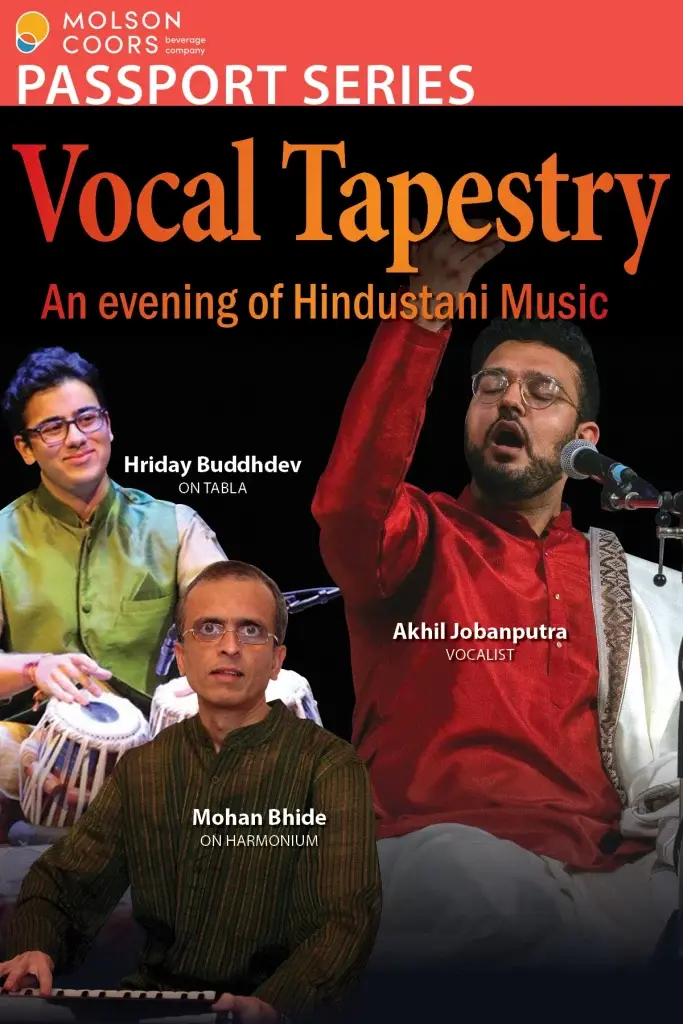Program Guide | Baithak Series: World of Raga
- Akhil Jobanputra

- Jun 17, 2023
- 4 min read
What's Hindustani music?
Hindustani music is one of two major forms of classical or art music found in India today, typically finding its representation across the North of India as well as Pakistan and Bangladesh, with the other major form Carnatic music being represented across the South and Sri Lanka. Khayal is one of the primary subgenres of Hindustani vocal music, which is what will be presented today. It represents a confluence of older musical traditions such as Prabandha, Dhrupada, and Qawwali. It developed an identity of its own in the royal courts of India, beginning with the Delhi Sultanate, and culminating at the courts of the Gaekwad kings of Baroda. It is primarily an improvised form, with the song-text providing a basis for spontaneous musical creation within the grammar of the raga (melodic form) and tala (rhythmic cycle). In modern times, Khayal has continued to evolve as one of the many living Indian performing art traditions practiced today.
What will be presented today?
Khayal | Raga Puriya Dhanashri
It has always perplexed me as to why Puriya Dhanashri is named as it is. The 'Puriya-ness' is clear, such as with the launch from nishad along with the highlighting of madhyam going back down into shadaj. However, its 'Dhanashri-ness' only became clear upon listening to Mansur ji's rendition of Multani Ang Dhanashri, along with my guru's elucidations. The brisk treatment of rishabh and dhaivat in the raga allude to the Dhanashri element, which also encapsulates a Multani-ang treatment in Puriya Dhanashri itself. Along with that, there is a downward harmonic grouping of D-M followed by P-G which is also stated in Mansur ji's renditions of Multani Ang Dhanashri, and is evident in this raga.
Song-Text #1: Aba To Rutamana | Vilambit Tintala (slow-paced 16-beat rhythmic cycle) | Traditional
Meaning: My pride has been hurt. I won't speak to you my beloved.
I've stayed up all night and my love for you has grown. Go to whomever's mind you have enchanted.
Song-Text #2: More Ghara Ayi | Drut Ada Chautala (fast-paced 14-beat rhythmic cycle) | Akhil Jobanputra
Meaning: You come to my home at midnight, with a face as beautiful as cupid's. Just a glance at it makes me fixated on you.
Your sandalwood-hued cheeks shine beautifully, making the stars around you flavourless in comparison. You, the autumn moon, please me with your enchanting form.
Khayal | Raga Savani Kalyan (Bihag Ang)
A rare raga, this version of Savani Kalyan carries traces of Bihag, the old Kalyan archetype, as well as some unique phrases of its own. This raga has come to be known as a speciality of the Jaipur-Atrauli gharana.
Song-Text #1: Deva Deva Satsanga | Madhyalaya Jhaptala (medium-paced 10-beat rhythmic cycle) | Traditional
Meaning: All the gods gather together in sacred discourse, in the refuge of Shiva.
The sky clad wise-man meditates, and similarly to Prahlada, beseeches Krishna so that he may always remain a devotee and thus relieved of all worries.
Song-Text #2: Jagadamba Maharani | Drut Ektala (fast-paced 12-beat rhythmic cycle) | Akhil Jobanputra
Meaning: O Mother of the Universe! O Great Queen! The gods and goddesses dance, sing, and play together in your refuge.
You are known as the Fierce One, eighteen-armed and mounted on a lion. You hold the trident (of concentration), sword (of worship), rosary (of internal vibrations), lotus (of peace). O Mother! You are the Bestower of Blessings.
Dhrupad | Raga Darbari Kanhada
An extremely popular raga, Darbari Kanhada is known for its grandiosity (often called the king of all ragas). I have often thought it is called as such as the raga really seeps into its environment, causing the feeling of a grand darbar (royal court) irregardless of where its being sung. It is known for its oscillations on the notes gandhar and dhaivat. And like all Kanhada ragas, the rishabh plays an extremely crucial role as a point of rest and strength.
Song-Text #1: Rajata Candra Lalata | Madhyalaya Cautala (medium-paced 12-beat rhythmic cycle) | Baiju Bawra
Meaning: A silvery moon on your forehead. You are three-eyed, reigning over the three realms. You hold Ganga (in your locks) and are the androgynous form of Shiva (consciousness) and Shakti (energy).
Draped in tiger skin, you are covered in ash and snakes with wild-flowing locks of hair. You are the blue-throated Shiva who defeats doubt and releases us from suffering.
All hail Shiva! All hail Shankara! He who resides on Mount Kailasa where devotees complete their observances patiently, upholding their sacred rites.
Lord of Baiju (the composer) and Medicines! The Great Time! Lord of the Universe! Lord of the Jujube Tree! Lord of Ghosts and Spirits! Lord of All! Lord of Life and Death!
Ghazal | Raga Mishra Bhairavi
This beautiful ghazal, composed by Shakil Badayuni and popularized by the legendary Begum Akhtar, gives a glimpse into how ragas are used outside of khayal and dhrupad. The raga becomes subservient to the poetry, with the primary goal of ghazal/thumri/dadra singing not to be about elaborating the raga, but elaborating the poetry.
Song-Text #1: Ai Mohabbat | Madhyalaya Dadra (medium-paced 6-beat rhythmic cycle) | Shakil Badayuni
Meaning: Oh love, I cry at our fate. I don’t know why I cried upon hearing your name today.
Each evening passes in anticipation of you. But something is different, this evening brought me tears today.
Sometimes I lament my destiny, sometimes that of the world. I’ve cried at every step of this journey (of love).
When the world at large alluded to love, ‘Shakil’ lamented his unsuccessful heart.




Comments